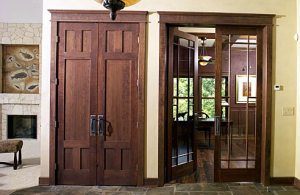What Is The Difference Between An Interior & Exterior Doors?
A door opens, and a door closes. It separates environments and provides entryways into new ones. However, they’re not all made the same and cannot fill the same roles.
Whether commercial or residential, every building will need both interior and exterior doors. For those without prior structural knowledge, doors may all seem the same. How different are they really?

THE 3 PRIMARY DOOR DIFFERENCES:
There are varying lever designs, accessory types, use of windows, materials and colors. But aside from obvious visual differences and preferences, functionality becomes a key factor in deciphering the needed door type. Here are some basic differentiators to consider when purchasing interior or exterior doors:
- Insulated Core
Perhaps the most crucial difference between interior and exterior door happens inside of the door. Based on purpose, each door type requires a different insulation levels. Varying levels of durability are required.
INTERIOR:
Most interior doors have no insulation at all, and are often completely hollow inside. Without the need to stand against weather predicaments, the interior doors serve as visual and mental barriers between rooms. They rarely include much noise or temperature protective capabilities.
EXTERIOR:
Exterior steel doors will need to accommodate for the inevitable weather abuse. They are made to be snowed on, rained on, battered and subjected to piercing UV sun rays. For this reason, they are difficult to transition into interior doors. The exterior door may have battle scars that make readjustments challenging.
- Material Uses
To understand why interior and exterior doors function differently, it helps to know how they are made. The materials used provides another primary door type differentiator.
INTERIOR:

Most interior doors are completely hollow inside. They are not soundproof or weather proof. For this reason, they are often made with a single material, typically wood or fiberboard. They are rarely made with metal.
EXTERIOR
: On the other hand, exterior doors are almost always made with steel or another type of metal in door companies. This makes them more expensive but much more durable. Exterior doors are able to protect against drafts and condensation. For anyone considering using an interior door for outside purposes, the additional costs of heating and cooling bills will quickly negate initial savings.
- Outer Appearance
The placement of decorative design distinguishes interior from exterior doors. Exterior doors often have facial decorations only on the one side. However, interior doors are made with double-sided aesthetic appeal.
EXTERIOR:

Outer doors are often sold with a face or veneer layer that is quite thick. This layer functions as part of the weather-stripping. When evaluating different options, you may see this feature listed as “glazing.” You’ll want to choose double or even triple glazing to provide additional protection. However, the level of protection needed will vary based on your given climate.
INTERIOR:
The inside door will not include weather-stripping features. Additionally, most interior doors are about 30” wide while their exterior counterparts are a larger 36” wide. While not immediately noticeable, those few inches will make a usage transfer quite the headache.
WHAT ABOUT MIXED USES FOR INTERIOR OR EXTERIOR DOORS?
When evaluating the differences, people typically want to know whether mixed use is a possibility. If they already have an exterior door, they want to know if that door can also be used as an interior door and vice versa. Can these door types be switched back and forth? Almost never.
Due to the additional strains required of outer doors, interior-built doors are completely inadequate for the job. They are lighter, thinner, smaller and are not conditioned for the elements. For those considering the option of add weather-stripping or adding the needed features, the installment costs will often outweigh the initial savings.
Since exterior doors contain more functionality bells and whistles, it’s more feasible for them to be used inside. However, the sizing difference alone makes this transfer improbable. To cut the door, you would need a professional table saw to complete the job. Additionally, you’ll likely screw up the aesthetic symmetry and potentially ruin the door through the structural imbalance.